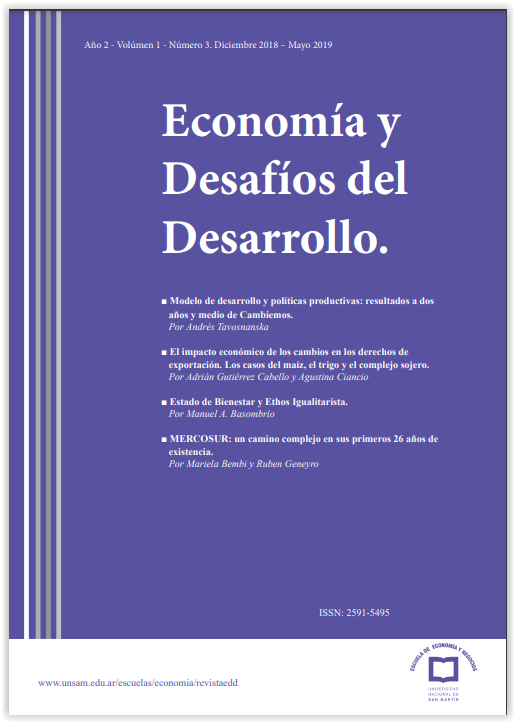Development Strategies and Policies:
Argentina after two and a half years of Cambiemos
Keywords:
Development policies, Development, International TradeAbstract
The administration that took office in December 2015 aimed to radically alter the economic direction taken by the previous government. This paper analyzes the changes related to the economic development model; examining the public policies introduced, with a sector-focused approach, and trying to draw conclusions from the results.
The production plan is similar to the classic strategies that tried to exploit the comparative advantages and profit from natural resources to develop the country. As an innovation, it also includes modern sectors, such as Knowledge-Based Services and tourism. One of the main differences with the previous development strategy is the minor role played by the manufacturing industry.
In general terms, the development policies targeted to deregulate and increase private profit margins. Horizontal policies replaced those more complex, vertical or selective ones. The strategy lacked coordination between areas, planning and private involvement.
The outcomes are disappointing. In the period under review, the private sector did not respond properly to the price incentives. The economy started to suffer a re-primarization process. Last but not least, the trade deficit grew larger as a result of this plan, contributing to the balance of payments crisis of 2018.
References
Alapin, H. (2008). Rastrojos y algo más: Historia de la siembra directa en Argentina. Teseo.
Alderete, M. V., & Formichella, M. M. (2016). Efecto de las TIC en el rendimiento educativo: el Programa Conectar Igualdad en la Argentina. Revista CEPAL.
Bisang, R., Anlló, G., & Campi, M. (2015). Políticas tecnológicas para la innovación: la producción agrícola argentina. CAF.
Bondorevsky, Diego (2017). Repensar la política regulatoria ante el retiro de los subsidios a la electricidad. Documentos de Políticas Públicas, CIPPEC.
Brambilla, I., Galiani, S., & Porto, G. G. (2010). Argentine trade policies in the XX century: 60 years of solitude.
Castro, L. & Levy Yeyati, E. (2012). Radiografía de la industrialización argentina en la posconvertibilidad. CIPPEC
Cimoli, M., G. Dosi, R. Nelson y J.E. Stiglitz (2006), Institutions and policies shaping industrial development: An introductory note.
Fort, T. C., Pierce, J. R., & Schott, P. K. (2018). New perspectives on the decline of us manufacturing employment. Journal of Economic Perspectives, 32(2), 47-72.
Gayá, R. (2016), “Fortalecimiento de los servicios basados en conocimiento en Argentina”, Subsecretaría de Servicios Tecnológicos y Productivos, Ministerio de Producción de la Nación
Gayá, R. (2017), “El comercio exterior en América Latina y las nuevas tecnologías”, Foro Nacional de Importadores Bogotá-Medellín, Colombia
Gutman, G., & Lavarello, P. (2014). Biotecnología Industrial en Argentina. Estrategias empresariales frente al nuevo paradigma. Buenos Aires: Gran Aldea Editores–GAE.
Lavarello, P. y Sarabia, M. (2015). La política industrial en la Argentina durante la década de 2000, Serie Estudios y Perspectivas, CEPAL Buenos Aires.
Lin, J.Y. (2012). New structural economics: A framework for rethinking development and policy, The World Bank
Llach, J. J., & Harriague, M. M. (2010). El mundo emergente y la demanda de alimentos: desafíos, oportunidades y la estrategia de desarrollo de la Argentina. Fundación Producir Conservando, Buenos Aires
López, A. (2017), “Tecnología, divisas, empleo: el rol del sector servicios en Argentina”, ECON 2017 FCE-UBA
López, A.; Pascuini, P. y Ramos, A. (2017), “Al infinito y más allá. Una exploración sobre la Economía Espacial en Argentina”, IIEP UBA-CONICET
Ministerio de Ciencia y Tecnología de la Nación (2016). Las empresas de Biotecnología de la Argentina 2016. Documento de Trabajo Ministerio de Energía y Minería (2018). Informe Trimestral de Coyuntura Energética. Primer trimestre 2018.
Ministerio de Turismo de la Nación (2016), Plan Integral de Gestión 2016-2019
Mota, J.; Morero, H. y Borrastero, C. (2017), “La industria del software: la generación de capacidades tecnológicas y el desafío de aumentar la productividad sistémica”, en Manufactura y cambio estructural: aportes para pensar la política industrial en la Argentina. Santiago: CEPAL, 2017. p. 283-330
Ordoñez, I. & Senesi, S. (2015). Campo: El sueño de una Argentina verde y competitiva. Aguilar.
Porta, P., Racioppe, B., & Zapata, N. (2015) Repositorios digitales y Políticas Públicas: el audiovisual en la web. REDCOM 2015
Presidencia de la Nación (2016), El Estado del Estado, SIGEN
Rodrigues, B. S., & Padula, R. (2016). Lithium Geopolitics in South America and the divergents national public policies. Meridiano 47, vol. 17.
Rodrik, D. (2004). Industrial policy for the twenty-first century. CEPR Discussion Paper N. 4767
Schteingart, D. & Coatz, D. (2015). ¿Qué modelo de desarrollo para la Argentina?. Boletín Informativo Techint N° 349.
Trejos, A., et al (2014). ¿Cómo repensar el desarrollo productivo?: políticas e instituciones sólidas para la transformación económica. Inter-American Development Bank, 2014.
UNCTAD (2017), “The ‘new’ digital economy and development”, UNCTAD Technical Notes on ICT for Development N° 8.
UNCTAD (2018). World Investment Report 2018 - Investment and New Industrial Policies. UNCTAD.



